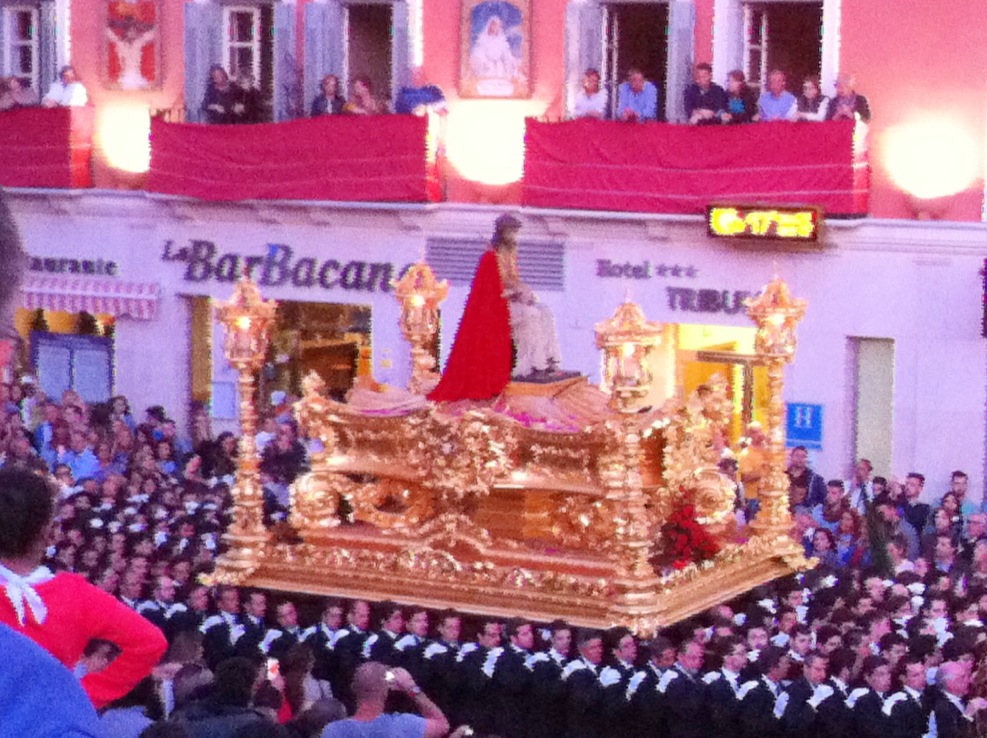 We were trapped at the top of the Tribuna de los Pobres. No chance of moving in any direction. Fortunately we were happy where we were. In front of us, on the bridge, El Cautivo (one of the grandest and most popular Semana Santa floats) had halted, accompanied by 500 Nazarenos in their tall hoods. Below us at the foot of the curved steps crowded with people, the beautiful float of Los Estudiantes moved slowly and majestically by.
We were trapped at the top of the Tribuna de los Pobres. No chance of moving in any direction. Fortunately we were happy where we were. In front of us, on the bridge, El Cautivo (one of the grandest and most popular Semana Santa floats) had halted, accompanied by 500 Nazarenos in their tall hoods. Below us at the foot of the curved steps crowded with people, the beautiful float of Los Estudiantes moved slowly and majestically by.
"Spain is Different". So their advertising slogan went some years ago. And never is it more true than in Semana Santa. This year was even better for me, because with a bit more knowledge I understood more and was in the right places at the right times.
 It had begun with food. Always a good start! The week before, Axalingua language school had organised a cultural class to learn more about Semana Santa, and it included coffee and delicious torrijas made by Juanmi's mum. These were a sort of eggy-bread with olive oil and cinnamon. While we munched, Juanmi explained all the different parts which make up each procession. Organised by the many cofradías (brotherhoods) in Málaga, each procession is headed by la cruz guia (the guide carrying the cross), then the guardería (the children of the members of the cofradía in their little costumes). Behind them come the Nazarenos (in their white or coloured cloaks and the capirotes or pointy hoods which symbolise Semana Santa in southern Spain), followed by the band.
It had begun with food. Always a good start! The week before, Axalingua language school had organised a cultural class to learn more about Semana Santa, and it included coffee and delicious torrijas made by Juanmi's mum. These were a sort of eggy-bread with olive oil and cinnamon. While we munched, Juanmi explained all the different parts which make up each procession. Organised by the many cofradías (brotherhoods) in Málaga, each procession is headed by la cruz guia (the guide carrying the cross), then the guardería (the children of the members of the cofradía in their little costumes). Behind them come the Nazarenos (in their white or coloured cloaks and the capirotes or pointy hoods which symbolise Semana Santa in southern Spain), followed by the band.
 Finally comes the trono (the throne, or float) carrying the image of Jesus. Depending on its size, the float is carried by anything from 120 to 500 hombres de trono (in Málaga women are still not permitted to join the throne-bearers). More hooded Nazarenos, all members of the cofradía, accompany and follow the throne, and at the rear are the penitentes - members of the public (dressed in ordinary clothes) following devotedly, often with candles. In many processions the whole thing is repeated for the second throne, that of the Virgin.
Finally comes the trono (the throne, or float) carrying the image of Jesus. Depending on its size, the float is carried by anything from 120 to 500 hombres de trono (in Málaga women are still not permitted to join the throne-bearers). More hooded Nazarenos, all members of the cofradía, accompany and follow the throne, and at the rear are the penitentes - members of the public (dressed in ordinary clothes) following devotedly, often with candles. In many processions the whole thing is repeated for the second throne, that of the Virgin.
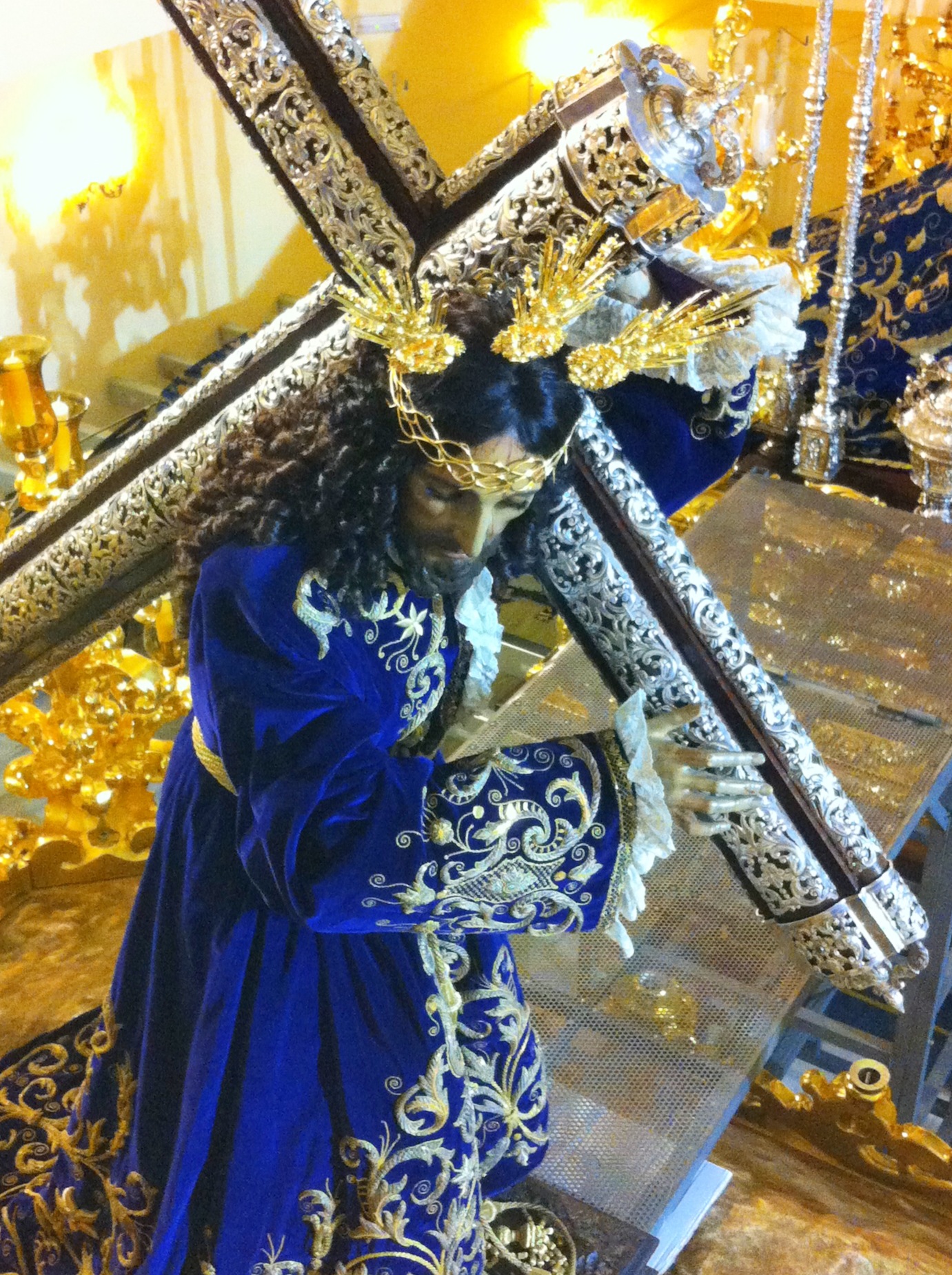 The following day Juanmi led us around Málaga, through some of the cofradías and into churches to see los imagenes (the statues of Christ and the Virgin which mostly remain in their local churches, until they transfer a few days before Semana Santa to the cofradía's base where the thrones are stored, to be prepared for the procession). We even had a private visit into La Casa Hermandad de Jesús el Rico.
The following day Juanmi led us around Málaga, through some of the cofradías and into churches to see los imagenes (the statues of Christ and the Virgin which mostly remain in their local churches, until they transfer a few days before Semana Santa to the cofradía's base where the thrones are stored, to be prepared for the procession). We even had a private visit into La Casa Hermandad de Jesús el Rico.
In a restaurant for lunch after the visit, there were a few Semana Santa themed menu items. I went for Torrija de Pan Brioche con Crema de Lima y Helado de Yema Tostada. Don't tell Juanmi, but these torrijas with rich lime cream and toasted egg-yolk ice-cream were EVEN more delicious than his mum's!
In my village of Colmenar, Semana Santa kicked off with the traslado, the transfer of the statue of Christ from the church to the cofradia's base, on Saturday night. It is a very serious part of the rituals, but it is before Semana Santa so the hombres de trono are not wearing the formal costumes which will be seen on Viernes Santo for the village procession.
So into Málaga for Lunes Santo, holy Monday, one of the most popular evenings for Málagueños as the city's favourite trono of El Cautivo goes by. With 240 hombres de trono to carry it, and 500 Nazarenos, this is among the most spectacular events of the week. And this year, either by good planning or just good luck, we were by the Puente Aurora at the top of the Tribuna de los Pobres to get a perfect view. The Tribuna de los Pobres is the "poor people's stand" - tickets for seats in the official Tribunas in Calle Larios or Alameda Principal are hard to get and cost over €150 (though that is for the whole week), but by Puerta Nueva the big fan-shaped steps offer the perfect free viewing point.
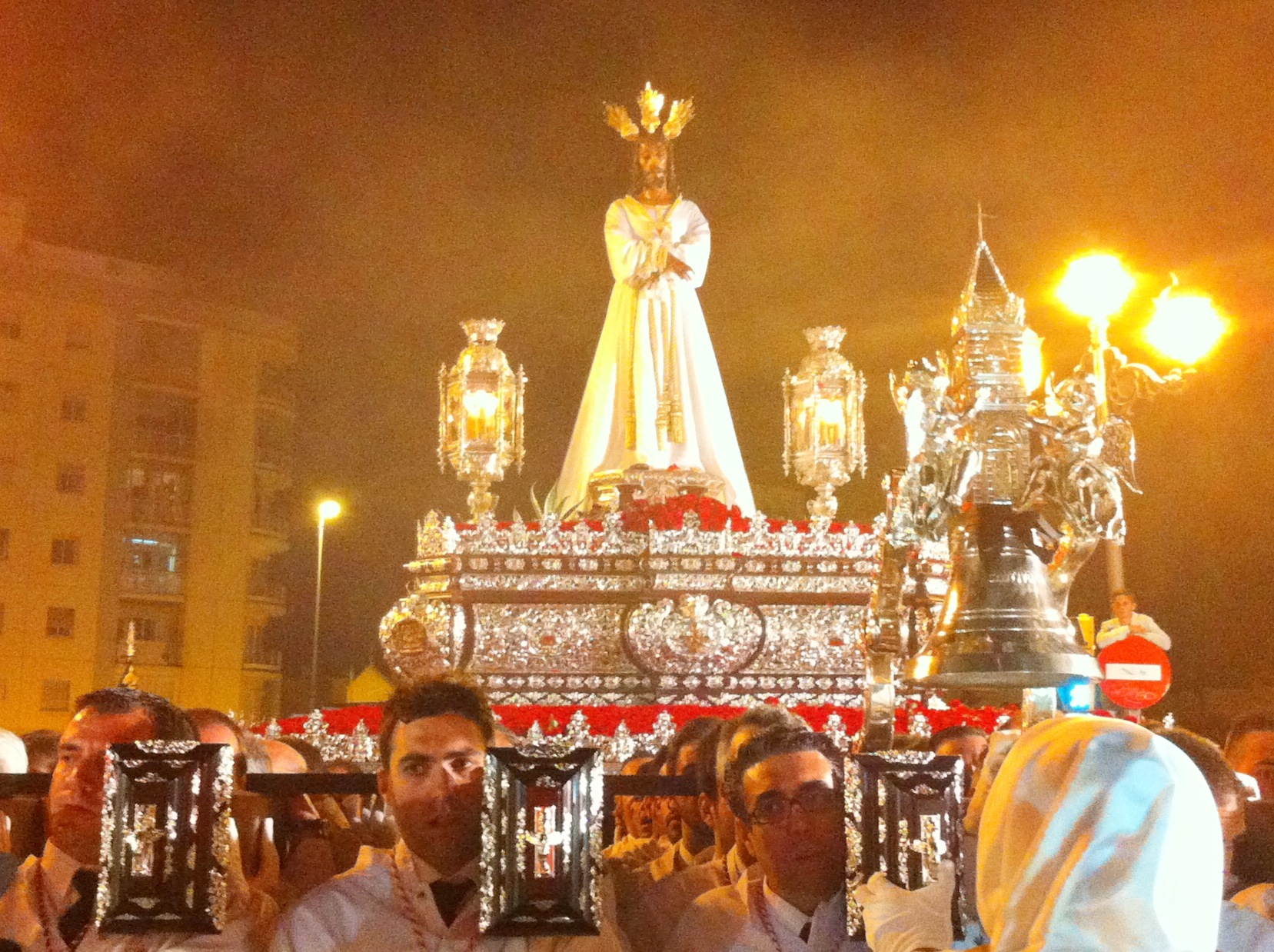 Below us at the foot of the steps Los Estudiantes carried their grand gold trono with a red-caped thorn-crowned Jesus (Santisimo Cristo Coronado de Espines) while in front of us on the bridge El Cautivo waited patiently, avoiding a clash of trumpets and drums. Once the competition was out of the way, El Cautivo continued, the hombres de trono probably glad of the rest. As the enormous trono turned the corner, people were pushed back against the wall to avoid the heavy swaying float. Behind it, the press of penitentes was huge and needed a phalanx of cofradía officials to control them.
Below us at the foot of the steps Los Estudiantes carried their grand gold trono with a red-caped thorn-crowned Jesus (Santisimo Cristo Coronado de Espines) while in front of us on the bridge El Cautivo waited patiently, avoiding a clash of trumpets and drums. Once the competition was out of the way, El Cautivo continued, the hombres de trono probably glad of the rest. As the enormous trono turned the corner, people were pushed back against the wall to avoid the heavy swaying float. Behind it, the press of penitentes was huge and needed a phalanx of cofradía officials to control them.
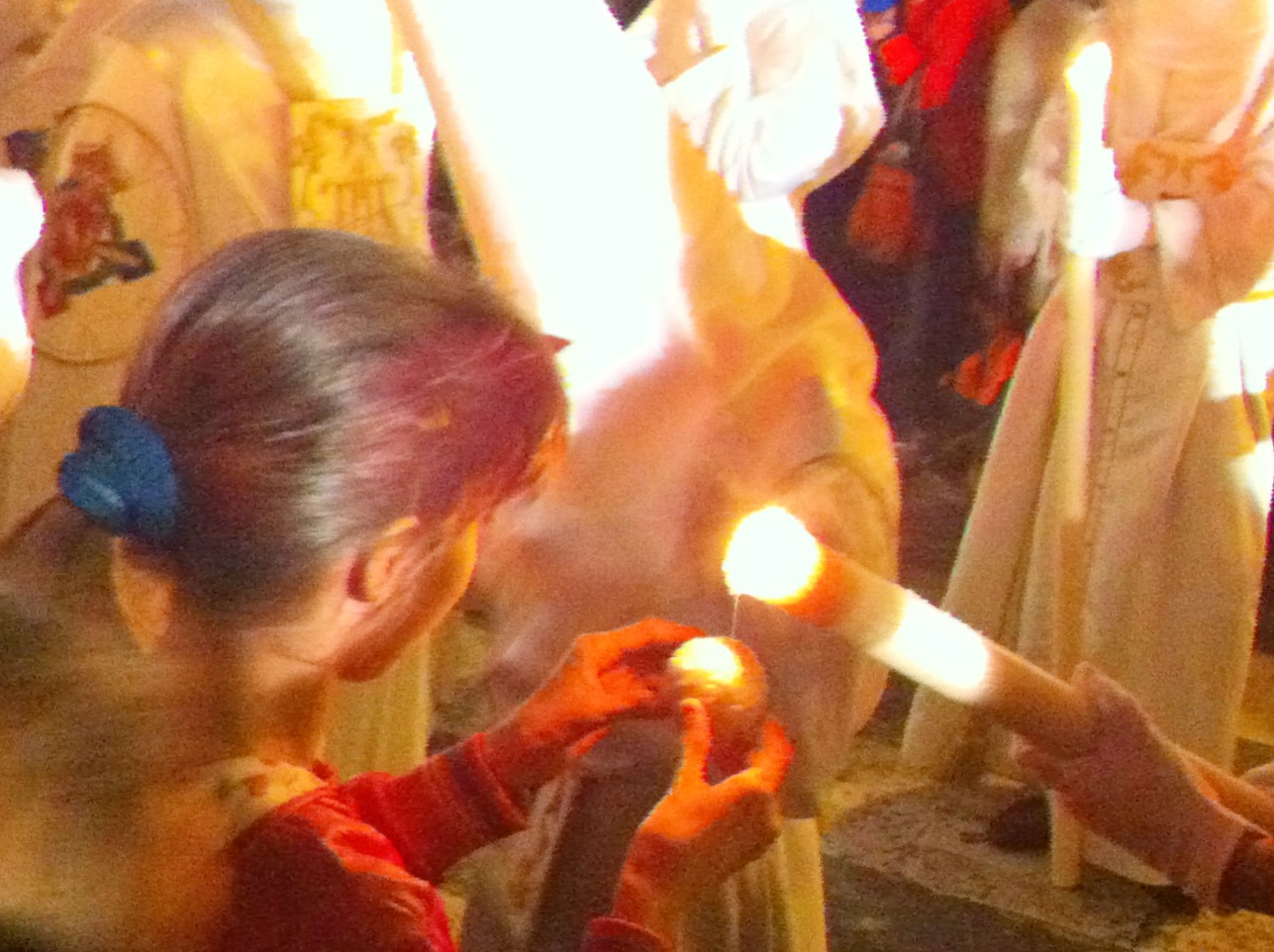 Children pushed forward and pleaded with the Nazarenos to drip their candles onto the balls of wax they will build up throughout the week. Above, on a residential balcony, a singer broke out into a saeta, a religious song. The crowd shushed each other to listen, and at the end he received well-deserved applause from the procession as well as the crowd.
Children pushed forward and pleaded with the Nazarenos to drip their candles onto the balls of wax they will build up throughout the week. Above, on a residential balcony, a singer broke out into a saeta, a religious song. The crowd shushed each other to listen, and at the end he received well-deserved applause from the procession as well as the crowd.
On Wednesday there seemed to be a Jesus on every corner. Thirteen tronos fighting for space. There were great views again from La Tribuna de los Pobres, contrasting with the formality of the ticket-only Tribunas in Calle Larios and La Plaza de la Constitución. An 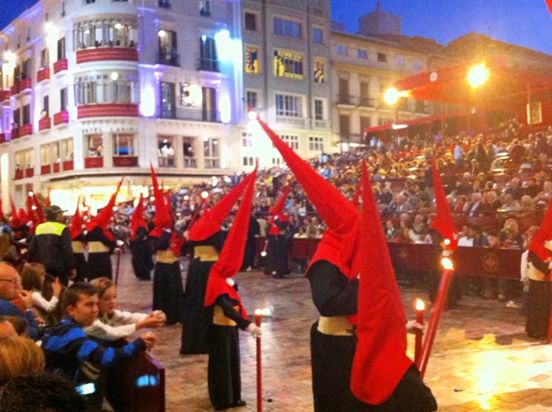 unfortunate clash of programming meant that bars just off Calle Larios were showing La Copa del Rey football match between Barcelona and Real Madrid, and even people in the tribunas had mobile phones clasped to their ears to listen to the commentary. Each roar from the bars was followed by whispers through the crowd – “Madrid scored first …” … “Now Barça have equalised …” … until finally Gareth Bale won it for Real Madrid just before close of play. A strange coming together of cultures, perhaps Spain’s two great guiding forces, football and the church, clashing in Calle Larios as half those present stood to pay their respects to La Virgen while the other half shouted with delight or despair at their teams.
unfortunate clash of programming meant that bars just off Calle Larios were showing La Copa del Rey football match between Barcelona and Real Madrid, and even people in the tribunas had mobile phones clasped to their ears to listen to the commentary. Each roar from the bars was followed by whispers through the crowd – “Madrid scored first …” … “Now Barça have equalised …” … until finally Gareth Bale won it for Real Madrid just before close of play. A strange coming together of cultures, perhaps Spain’s two great guiding forces, football and the church, clashing in Calle Larios as half those present stood to pay their respects to La Virgen while the other half shouted with delight or despair at their teams.
And as always, the event was hugely emotional. You don't need to have one iota of religion in you to be moved by Spain's Semana Santa. You can marvel at the riches of the churches and the cofradías, you can wonder for a moment whether the money could have been spent more usefully, and you can watch bemused as penitentes and  members of the watching crowds sob and even fall on the ground as their beloved statues pass by. But you cannot ignore Semana Santa, and you cannot fail to be impressed by the organisation, the devotion, the sense of community (and not only in the cofradías but amongst the crowds as well). "Spain is Different"? Oh yes. And Semana Santa is special, for those with faith and for those without who just like a good party.
members of the watching crowds sob and even fall on the ground as their beloved statues pass by. But you cannot ignore Semana Santa, and you cannot fail to be impressed by the organisation, the devotion, the sense of community (and not only in the cofradías but amongst the crowds as well). "Spain is Different"? Oh yes. And Semana Santa is special, for those with faith and for those without who just like a good party.
Now, anybody fancy a chocolate-covered Nazareno?
NB - For a slightly more reverent take on Semana Santa, see my post last year "The Splendour and the Silence".
© Tamara Essex 2014
THIS WEEK’S LANGUAGE POINT
Odd isn’t it, how sometimes something just doesn’t mean the same thing in a foreign language? One of the things I am often asked as an extranjera is how long I have lived in Spain. If I were to answer in English, I would of course say “I have lived here for almost two years.” So, having learned my present perfect tense, I respond in Spanish “He vivido aqui casi dos años.”
But that’s wrong. In Spanish that implies I have lived here before but I don’t any more. For example it WOULD be correct to answer the question “Have you ever been to Australia?” with the reply “Si, he vivido allí tres años” – yes, I have lived there for three years. But I don’t now.
Because the present perfect is, in fact, a past tense. He comido la manzana – I have eaten the apple, and I have finished eating the apple – the apple is no more. He aparcado el coche – I have parked the car. I am not parking it now, it is parked and now I am here in a bar with you telling you I have parked it.
OK that sort of makes sense. Certainly “I have lived here” is the only time I would try to use that tense for something that is still happening, so it figures that it is wrong. The truth is that it is the English that is wrong!
So the correct reply to “How long have you lived here?” needs to be –
“Llevo viviendo aqui casi dos años.” or “Vivo aquí desde hace casi dos años.”
(PS – a reader has suggested that I paste all the language points into one document, and publish that as a “pinned post” in the blog header. That sounds like a good idea, as I have occasionally wanted to find a particular language point but had no idea which blog it was in. So this will happen shortly.)